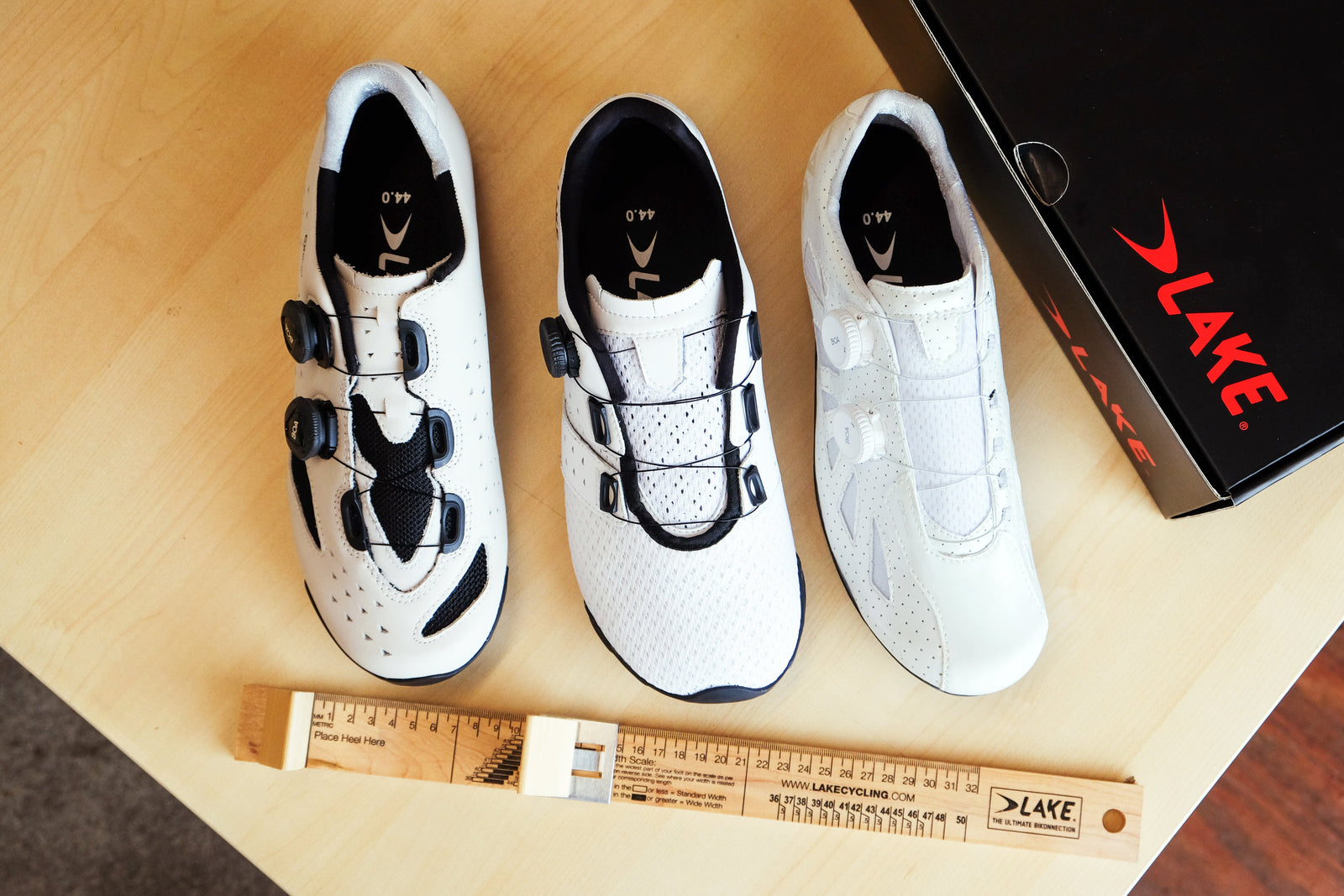Different shoes for different tasks

Variety is the spice of life – especially for feet
Here at Lake Cycling, we design several types of cycling shoes. Thankfully, we also have lots of different shoe ‘lasts’ – you remember, we spoke about this back in 2022 (here’s a reminder). In effect, the shoe ‘last’ is the thing that determines the shape and ultimate usage of the shoe. It’s the heart on which every other aspect of the cycling shoe is designed.
There’s a reason why we have such a vast a range of road cycling shoes, and off-road cycling shoes. Ultimately, as we keep on saying, we’re all quite different, and how our bodies and our feet have developed is determined by many factors. One important factor is the lifestyle and activities that you took part in during those important adolescent years. Okay, let’s hear what Hutch, our Chief Designer here at Lake says about this, and how it all effects your foot shape and ultimately, the right shoe for you when cycling.

The Pro Rider Cycling Foot
As most pro cyclists have been riding bikes for long hours since a very early age, they haven’t really spent as much time ‘on their feet’ as other youngsters. This basically means that their feet haven’t developed in the same way, because they simply haven’t been the same load-bearing and shaped to modern cycling race shoe during body development stages. In the main, pro cyclists tend to have narrow feet – hence those super narrow looking cycling shoes that they all seem to wear. As regular cyclists since childhood, these riders and indeed some others, are usually also slim in their build, light in weight and haven’t spent entire adult life wearing dress shoes, flip flops etc. Their general foot shape is therefore quite slim, as with many top-level race shoes – like ours here at Lake cycling too – being narrower than those designed for the general consumer and the average Joe cyclist.
Cycling shoes such as our Lake CX /MX 403 are specifically designed for this pro level racer; and, in truth, even if you’ve taken to cycling with a passion since your late 20s onwards, they simply may not be the shoe for your wider and bulkier foot, which has developed more for load bearing. This is also why we like to look at your feet and to measure you in detail.

The Born-Again Cyclist & General Population
When Hutch is designing our cycling shoe ranges, he takes into account demographics, and the variances between foot shapes and sizes around the globe. There’s a lot to analyse if we’re going to wrap your feet in comfort.
The issue arises when the born-again biker takes it upon themselves to kit themselves out as an 80kg man, not a slightly larger and somewhat more normal rider. Yes, you can buy that top of the range carbon road bike, and that ultra-aero and light-weight kit; and yes, you can buy the same cycling shoes as a Tour de France winner, but… it won’t make you ride like them, and the shoes may well cause a number of issues and the type of foot pain that we’ve previously discussed here on our Lake Cycling blogs.
The widest range of cycle shoes – literally
Thankfully, here at Lake we design shoes for all sizes and all types of cyclists. Your body has formed in a specific way, due to the actions and activities that you participate in and always have. You can change muscle mass and weight, but the basic underlying structure is already in place by the time that you reach your mid-20s. If your foot has never really spent a lot of time load bearing, then your foot doesn’t bulk up – as with the average pro rider. If you’ve done lots of running for example, then a running shoe has less structure to the upper and less upper and lateral support. If you run in shoes that are too narrow, you’ll get bunions – and, can happen in cycling shoes. Whilst cycling shoes have more support and structure, they still need to actually fit your own unique feet. Which is why our Lake CX 403 road shoe – the ultimate in performance cycling shoes - may not be the ideal shoe for you, even though it’s a top of the range. Ultimately, it’s built on a race last, for top level racers and their feet. You may be far better suited to wearing our Lake CX 332 on your feet, as it’s a shoe which has more volume and width designed to the ‘upper & sole’.
CX 403$549.99 |
MX 201$279.99 |
The wide range of Lake Cycling Shoes
Here at Lake, we e have to think about this when we make our cycling shoe ranges. People may have an active lifestyle, but they may work in an office and have a different load bearing to their feet, and their feet will be more robust. We take this into account when we design shoes - the foot shape, in all its aspects. Here’s an idea of the different number of cycling shoes ‘lasts’ that we’re currently using at Lake, and where each one is generally aimed. For every 500K people, there’s at least 3 variations of foot shapes. Currently, here at Lake we use 5 ‘lasts’, then we have different width fittings within some of these. For example, we use 3 widths within the ‘Race last’ and 2 in other lasts. So, right now about 14 last variations of shapes and widths
- Sport last – more generous. Closer to the normal sports shoe. More width, Higher instep, more volume. That’s the majority of us and our feet. It’s useful if someone is coming to the sport after 25 years and their foot is full grown, full width and not narrow.
- Race last – Pro cyclist design… not necessarily the average rider who happens to be able to afford a Pinerello. If you don’t have the body to make all that stiffness work for you, it’s not the cycling shoe for you. You need to go down to the CX /MX332, which is more forgiving;
- Competition last, which has 2 width fittings;
- Winter last, with 2 width and more volume in the toe box.
- Comfort plus last, with 1 width and which generally fits anyone, but which is definitely for toe splay – natural foot shaped shoe.
Natural foot or Toe splay
We’re the first cycling shoe brand in the world to offer this roomier natural foot shape, or ‘toe-splay’ design, and the first to offer this in a full collection. It has a toe box shape like your actual toes when spread, and allows for toe splay – like barefoot running, and gives you that necessary power. It’s ideal for giving the general cyclist, ideal comfort and performance in harmony – which has to the goal – pain free cycling feet.
The constant evolution of society
Add to all of this, that over recent times, demographics of people have changed. Diet has changed and how our body grows. The average size of people has changed dramatically in so many ways. And yet, in truth, not too many cycle shoe brands take this into consideration, whilst we offer many ‘lasts’. Here at Lake, we’re realistic and we can’t expect everyone to have a body and feet like a pro cyclists. Especially with the modern aspect of cross-training with consumers, and its effect on feet. We can’t simply tell the consumer that their foot is wrong. Instead, we have to study them and take so much into consideration when we design our range of road cycling and off-road cycling shoes, ensuring that we take into account everything here that we’ve highlighted here in this blog.
By doing so, we’re able to interact with you, the cyclist, what your foot shape and type is, and to listen to you and help you to find the perfect cycling shoe for your own riding. After all, if you can’t be a pro peloton rider, you can at least wear the very best cycling shoes in the world – by Lake.











Please make your shoes lighter. They are just too heavy. And the excess roominess in the heal is problematic. I wear the mx238.
Please do a narrow heel (like CX332) version of the CX201. Having a wide, flat forefoot doesn’t mean you have a heel and ankle like someone with elephantiasis.
Can you say something more about the toe splay and which shoes has this last?
Leave a comment